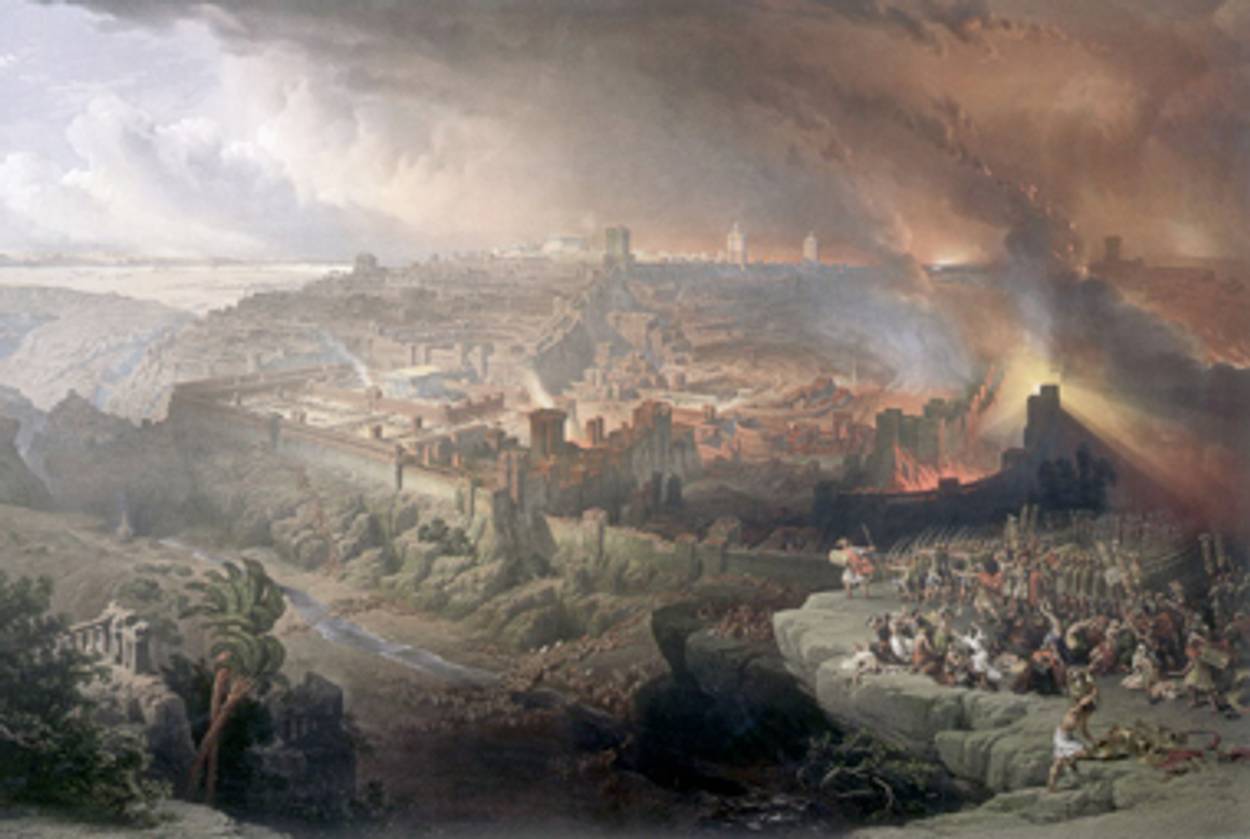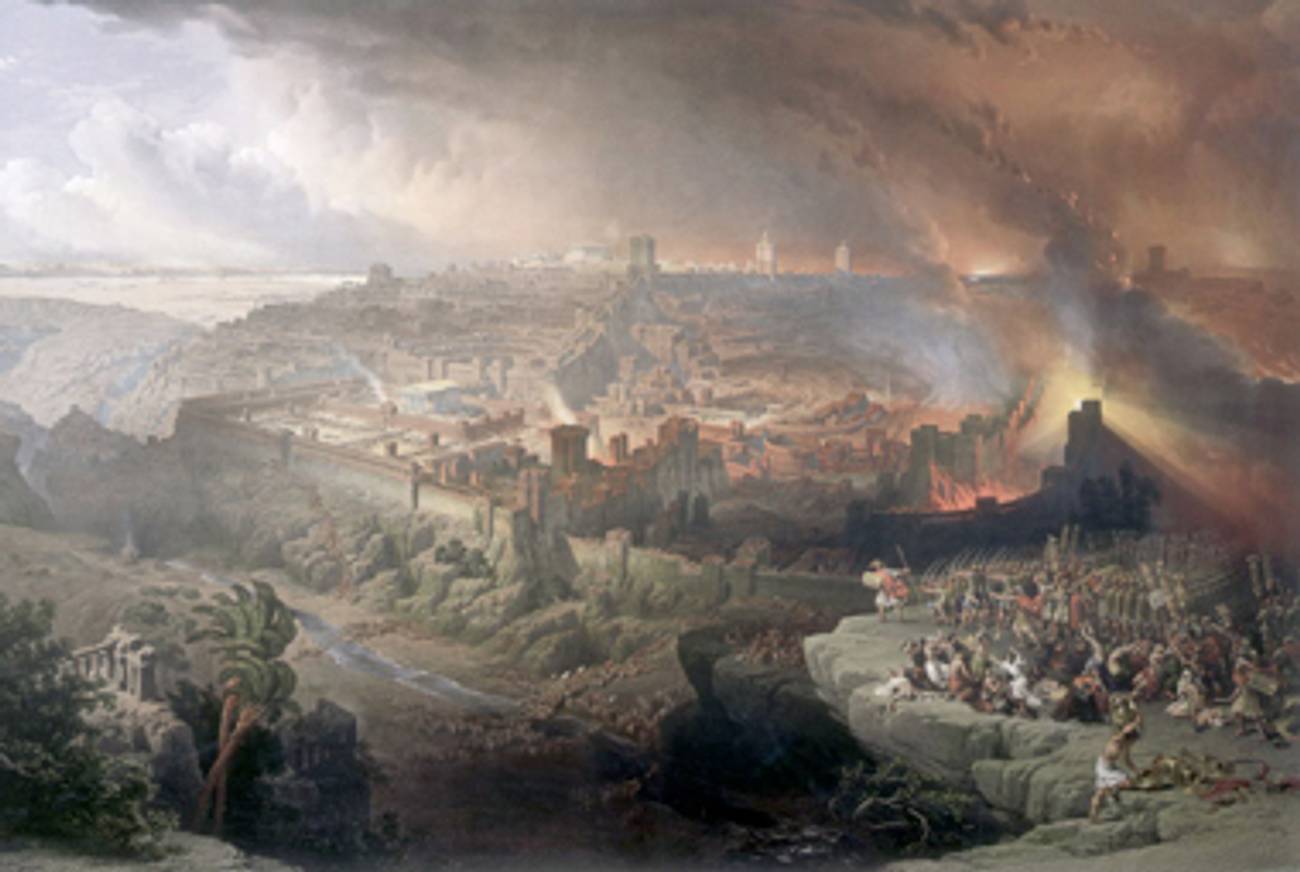Evil Inclination
In Jerusalem, Jerusalem, James Carroll uses the city as a metaphor for the human tendency to combine religion with violence




It’s not clear whether there really is such a thing as “Jerusalem syndrome,” the religious mania that supposedly afflicts some visitors to Jerusalem. But there can be no doubt that the West as a whole has often fallen prey to a version of this sickness—what James Carroll, in the introduction to his new book Jerusalem, Jerusalem: How the Ancient City Ignited Our Modern World(Houghton Mifflin Harcourt, $28), calls “Jerusalem fever.” This fever, as Carroll defines it, is the “transformation of the earthly Jerusalem into a screen onto which overpowering millennial fantasies can be projected,” and it lies at the very heart of Jewish, Christian, and Islamic belief.
For all three faiths, history begins in Jerusalem—it is the city where Solomon built his Temple, where Jesus suffered his Passion, and where Muhammad went on his visionary night journey. And it is also the destination where history is leading. For millennia, Jews have prayed “Next year in Jerusalem,” and we still do, even though we could go there any day of the week. Christians, meanwhile, looked forward to the New Jerusalem, the heavenly city foretold in the Book of Revelation: “the city of my God, which is new Jerusalem, which cometh down out of heaven from my God.”
“Only Jerusalem occupies such a transcendent place in the imagination,” Carroll writes. “It is the earthly reflection of heaven—but heaven, it turns out, casts a shadow,” the shadow of war and terrorism and massacre. According to Carroll, “over the past two millennia, the ruling establishment of Jerusalem has been overturned eleven times, almost always with brute violence, and almost always in the name of religion.” Some of these invasions are central to Jewish memory—the Babylonian conquest in 586 BCE and the Roman siege of 70 CE each led to the destruction of the Temple, and to profound changes in Jewish identity.
Then there were the Sassanid conquest of 614 CE, when Zoroastrian Persian armies took the city from the Byzantine Empire; and the Arab conquest of 638, when Caliph Umar entered the city on foot as a token of humility; and the Crusader victory of 1099, which the Christian Franks celebrated by massacring Jews and Muslims; and the British victory in 1917, when General Allenby took the city from the Ottoman Turks during World War I. Most recently, of course, there was the Israeli conquest of 1967, when the city’s sacred sites returned to Jewish possession for the first time in almost 2,000 years. Initially hailed as a miracle, this was also the beginning of Israel’s occupation of the West Bank—a victory whose cost mounts and mounts as the years go by.
No wonder there have been so many books written about the history of Jerusalem. The title of Carroll’s new work makes it sound like still another of them; but the further one reads in Jerusalem, Jerusalem, the clearer it becomes that the title is misleading. The reader of this book will learn only the basic outlines of Jerusalem’s history, and still less about its geography, culture, architecture, or even its representation in art and literature. At moments, one begins to wonder if Carroll put the city’s name in the title twice to make up for the fact that it is so elusive in the book itself.
What Carroll is really doing, in the best tradition of the Jerusalem-fevered, is using the city as a metaphor—in this case, a metaphor for the human tendency to involve religion with violence. This is the “shadow” of which Carroll writes, and if it is cast by Jerusalem, it can fall virtually anywhere; wherever Europeans or Americans have killed in a righteous cause, Carroll feels Jerusalem’s presence. The conversion of Constantine, Columbus’ discovery of America, the Thirty Years’ War, the Freemasons, the American Civil War, World War I, the Grand Mufti, McCarthyism, the Eichmann trial—as long as it falls under the broad theme of sacred violence, it finds a place in this book. At times, Carroll seems to grasp at the slimmest of Jerusalem connections: Herod’s Temple in Jerusalem was “marked” by “Greek architectural style,” and so is the Lincoln Memorial; and just before he was shot, Lincoln mentioned that he wanted to visit Jerusalem. There is something almost conspiratorial about these arcane affinities, and Carroll treads on Dan Brown territory when he muses darkly on the power of the Knights Templar—named, of course, after the Temple in Jerusalem.
But if Carroll has been driven a little mad by Jerusalem, it is with a noble madness. While the subtitle claims that Jerusalem “ignited our modern world,” Carroll’s real argument is that the city only symbolizes an ancient entanglement of sacredness with violence. Just how ancient becomes clear in the second chapter, “Deep Violence.” “Where did Jerusalem and all that it implies come from?” Carroll asks, and his answer begins this way: “Thirteen billion years ago … all matter was concentrated into a single point.” From there, we are launched on a whirlwind tour of cosmic evolution, from planet formation down to the emergence of primates with opposable thumbs, until we get to the first homo sapiens.
Inspired by the “mimetic theory” of the French thinker René Girard, especially Girard’s famous work Violence and the Sacred, Carroll speculates that the human need for religion grew out of the fear and elation primitive men experienced in hunting animals. Animal and human sacrifice was a way of containing man’s potential for violence through ritual: “Sacrifice is the ritual par excellence, the act of making something holy by killing it.” And archeology tells us that Jerusalem itself, a high point surrounded by valleys, was a site for such primitive sacrifices long before it became David’s capital.
Some memory of this past, Carroll argues, is encoded in the story of the binding of Isaac, which took place on Mount Moriah—traditionally held to be the same as the Temple Mount. The story of the akedah is fatefully ambiguous. On the one hand, it shows that the God of Abraham, who would become the God of Jews, Christians, and Muslims, does not desire human sacrifice—he sends a ram to substitute for Isaac, marking his difference from Canaanite deities like Moloch. On the other hand, as Kierkegaard insisted, it is Abraham’s willingness to kill his own son that proves his perfect faith in God. Many true believers, from the Masada Zealots to today’s Islamic suicide bombers, would follow his example.
To Carroll, the whole Bible—the whole history of religion—can be understood as a dialectic between sacred violence and sacred rejection of violence. As a deeply humane, intellectually scrupulous man—a former priest turned liberal Catholic—Carroll believes that religion is, or should be, moving in the direction of peace. The Hebrew Bible, as he reads it, progresses from the murderous Yahweh of Exodus to the ethical self-criticism of the Prophets: “Against the violent God, the Bible proposes a countervision of God, a deity whose most solemn allegiance is not to the perpetrator of violence but to its victim. God does not sponsor violence but rescues from violence.”
This movement from a vengeful to a loving God has often been cast, in Christian apologetics, as a rejection of the Jewish God in favor of Jesus Christ. But Carroll, whose acclaimed book Constantine’s Sword is a landmark dissection of Christian anti-Judaism, specifically rejects this supersessionist view. Rather, he sees Christianity itself as containing both these poles and laments that it has so often followed its evil inclination. Born out of Jesus’ message of universal acceptance, Carroll writes, it devolved into the state church of Constantine’s Empire, then into the warring faith of the Crusades.
It is the anti-Semitism of the Gospels, the way they blame the Jews for the death of Jesus, that represents, for Carroll, Christianity’s original sin. “The fatal character of this structure—Christianity born of and nurtured by the same scapegoating violence that killed Jesus—has yet to be fully faced,” he concludes. And throughout Jerusalem, Jerusalem, it is always Christian and Catholic violence that most disturbs Carroll. Likewise, as an American, he is uniquely offended by the violence America has committed in the name of its own ideals. Just as he finds good and bad tendencies in the Bible and the Church, so Carroll’s sketches of American history contrast what he admires—above all, the legacy of religious tolerance bequeathed by Roger Williams, Anne Hutchinson, and the Quakers—with what he despises—the conviction of exclusive righteousness that led to the mass slaughter of the Civil War and World War I.
In the end, Carroll makes this dualism explicit. What we need, he believes, is not to replace religion with reason—reason breeds its own monsters—but to replace bad religion with good religion. “Given the depth of religion’s complicity with violence, what would good religion look like, anyway?” he asks, and gives a five-part answer. Good religion celebrates life, not death; believes in the unity of all men, as a reflection of God’s unity; cares more about knowing God (revelation) than avoiding punishment (salvation); and refuses to coerce believers. Finally, and “paradoxically, [it] may have a secular character,” in the sense that the religious impulse may oppose traditional organized religion. Given the bloody history Carroll recounts, it would surely take a miracle for such a “good religion” to prevail on Earth; for it to bring peace to Jerusalem would be the biggest miracle of all.
Adam Kirsch is a poet and literary critic, whose books include The People and the Books: 18 Classics of Jewish Literature.
Adam Kirsch is a poet and literary critic, whose books include The People and the Books: 18 Classics of Jewish Literature.